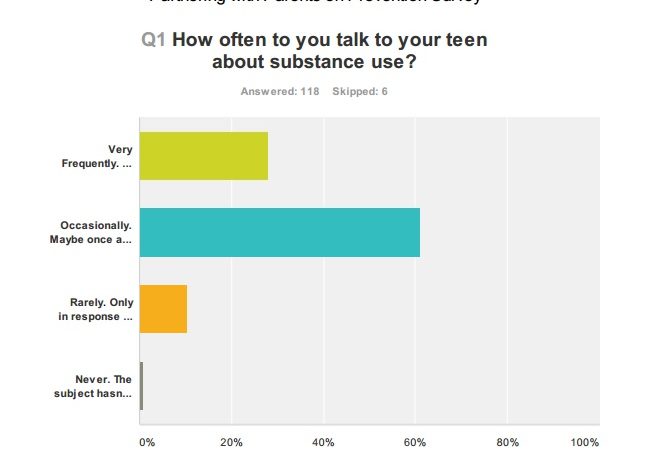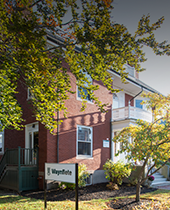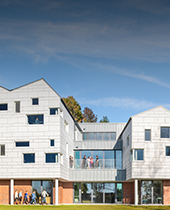The Prevention Partnership
Each spring, with the end of the school year in sight and celebrations in the air, the Upper School administration and parent association leaders seek to engage the parent body in conversation about preventing risky behavior. After the evening with Geno Ring in the fall on parent/teen communication, we surveyed parents to glean insight into their strategies and habits regarding talking with their teen about substance use and other risky behavior. This spring, we are engaging parents with this topic through the following article, which summarizes and reflects on the survey results.
It feels familiar as parents to be constantly adjusting expectations for our children (much as we are all having to do with our hopes for spring weather) as a result of observing them handle each of life’s demands. Our kids grow up quickly but the growth trajectory is by no means a straight line. Growth happens exponentially around significant incidents but is most often maximized during courageous conversations before, during and especially after these events or milestones occur. Last fall, we asked US parents in a survey how often they talked with their teen about substance use and other risks and whether they would share effective ways to discuss expectations with their child. 61% of parents responded that these conversations happen around once a month and another 28% say they initiate the topic very frequently- at least once a week. We share observations and suggestions in the survey data as another catalyst for initiating timely and hopefully mutually beneficial conversations.
Talking with other parents is one of the best resources in a small community as the safety message is strengthened by a chorus of similar voices. As one parent stated, “I am not sure there is one way. It’s like teaching, it has to be presented in multiple scenarios and media.” While there is no best time, many said, “We started talking about drugs when the kids were in lower school. These are topics that should never stop being brought up.” Another said, “We talk about what’s illegal, what’s immoral, what’s bad for your healthy and what’s just reckless and stupid. We explain that we love them and want them to get through their teen years with as few negative/dangerous/destructive learning experiences as possible and we emphasize that they can tell us what’s going on…” Words to describe the tenor of these conversations included “bluntly,” “frank,” “honestly and directly,” “casually,” “privately, with a generous amount of listening,” and “being candid and real.”
Many parents mentioned making use of the well-documented research about the impact of substances on healthy teen brains. “We talk about sugar and caffeine as examples of substances that can lead to cravings/addiction and unhealthy habits but also have a place re moderation but we also talk about cell splitting in teens and why age genuinely makes a difference.” One respondent praised the 9th grade film/seminar curriculum presented to parents about binge drinking last spring for the “Here-are-the-potential-consequences-to-your-brain-of-these-accidents” but said parent conversations need to go deeper and get personal because of the “yeah, but it would never happen to me” attitude. Another described moving from a “cautionary tale” approach to a more curious stance, “What would you be hoping to get from the experience of drugs and alcohol? What might be going on underneath that risk-taking – ambivalence, anxiety, fear? and can we help you address THAT?” If students express that risk is inevitable, are you providing an alternative viewpoint?
Regardless of the science, many say they make it a regular routine to “talk before parties and social gatherings” knowing that students may have to make many decisions about safety in a single evening. Perhaps the most salient emerging research is on how teens influence one another in social situations. As one parent wrote, “I wish I could say that talking with my teen has helped a lot- and maybe it has- but it seems that peers still have an enormous impact on how my child acts.” Click here for a recent NYT article on peer influences that might help generate increased self-knowledge for your teen.
Many parents did raise how hard is its “to know if it’s been effective” when initiating talks. A survey by the pediatrician supported HealthyChildren.org states that more frequent messages at home reduce the risks of substance use significantly claiming “overall, those whose parents ignored the issues were about two times as likely to use drugs than kids who learned “a lot” at home.” Click here for more, including tips on what you can say to your teen. Other conversation catalysts included “sharing family histories,” “talking about our own experiences,” “bringing up an issue in the news,” “listening to their radio station in the car and talking about lyrics” or “witnessing the effects on other friends.” Often teens will “readily join the conversation because it is not directly about them” but the information is getting across nonetheless. One parent appreciated their child’s sense “that they would let their parents and teachers down,” something they can only feel if we share regularly how vitally important they are to all of us.
Survey responses about protective factors that help teens navigate critical decision-making were inspirational and positive. “We engage our children regularly on how they would like to spend their time- then support those activities and get involved.” “Communication is the number one factor,” said another as is “self-awareness” and “promoting in ourselves and in one another mindfulness, emotional awareness/intelligence, and learning how to work skillfully with our own emotional mind-states.” One family reported the importance of their child “having their own therapist who he sees when he wants” has made a big difference increasing opportunities for conversation, but other adult friends and coaches can play a similar role in getting curious and “asking our kids about their “pretty bright future,” “passionate interests” and short and long term goals they are feeling excited about.
This time of year, whether we are looking ahead to the milestones of graduation, first jobs and volunteering for real employers, or other major social or family events (hopefully hosted in summer temperatures) we can count on risk-taking to occur as it is how we humans grow. In seminar, we emphasize that there are some risks that are just never worth taking. A key message, as one parent pointed out is “teaching that substance use is a distraction to a healthy lifestyle, an investment in time and a slippery slope that can quickly lead to a life long struggle to manage (Life is complicated enough).” Finding the courage to talk may be the biggest hurdle, but when we do, a simple message that we care can be powerful especially when it comes from many places. Whether or not the conversation goes “well” or propels us to totally unexpected places where we have to re-find solid ground, if we come from an informed, transparent, and deeply invested place – our kids will feel they are a vital part of the partnership with us in preventing tragic consequences during this time of community celebration.
Thank you to all the parents who Click here for a list of Chaperone Guidelines from the Hazelden Foundation.



